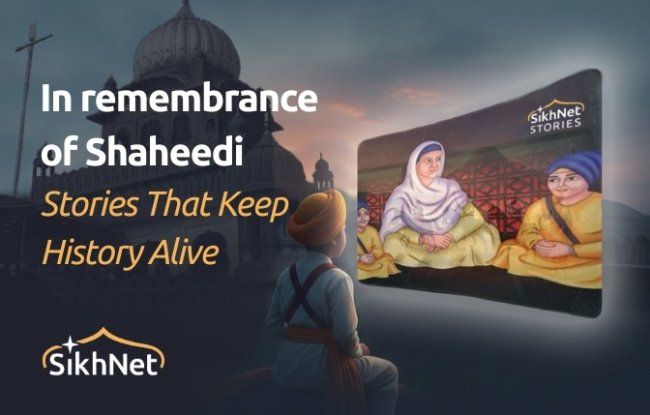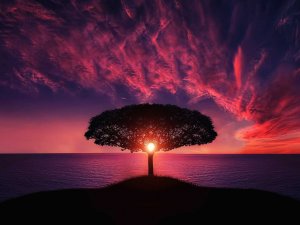Our past shapes, or misshapes, us making us what we become. The past is the foundation, brick, and mortar needed to create a durable protective shield for our existence. So, we can't possibly walk away from it. To willingly disown the past is not only impossible (its lure is tighter than a boa's embrace) but could be suicidal to our sense of self.
The present is in the moment, but we use it mostly to rue the past while drooling for a magical future. Yet, life requires adjusting to changing times and realities. Time marches on.. How to accommodate this inevitably changing reality while resisting the change at the same time? How then to build a future to define us without denying the past?
All existence is just a moment of time between the past and the future; “Hum aadmi haen ik dami”(Guru Granth p 660). But the moment can destabilize and threaten, making for inner conflict. Ergo, resistance to the change that comes with time becomes an essential defense mechanism to preserve our sense of self.
Let's come to this from another perspective.
Human societies – primitive or modern – are rooted in tradition. Traditions are the glue that binds a people into a community. Like the forces that unite electrons and atoms to create complex molecules and larger structures, cultures develop families, communities, even nations. Some traditions come to define the foundations of religions, others form belief systems of civil societies, without an associated religious identity.
Both religious and secular societies resist change and amendments of their laws and traditions. This creates stability. But at times non-religious civic societies are expected to respond to changing times, and they do so with interpretations or modifications of hallowed traditions. Religions, on the other hand, resist such freedom of thought and action because their traditions become etched in stone, since their formulations become coated with unnecessary non-earthly governing structures.
Every so often, we need to revisit, review, and re-examine our laws, traditions, and conventions --- both secular and faith-based --- to understand what time has wrought. I offer a simple illustration to make my point. Surely readers will add and subtract as they should.
Take, for instance, the notion of amrit vela in Sikhi. Amrit Vela - literally 'the ambrosial hours,' is conventionally thought of as the pre-dawn hours (perhaps between 3 - 6 AM.). It is then that our inner and outer environmental existence is most conducive to the divine ambrosia of naam. Sikh tradition asks a Sikh to start the new day at Amrit Vela.
ਅੰਮ੍ਰਿਤ ਵੇਲਾ ਸਚੁ ਨਾਉ ਵਡਿਆਈ ਵਿਚਾਰੁ ॥ ਕਰਮੀ ਆਵੈ ਕਪੜਾ ਨਦਰੀ ਮੋਖੁ ਦੁਆਰੁ
Meditate in the sweet hours before dawn on the Nam, deep and vast. Your karmas will all be covered and the door of freedom will open. (Japji Sahib Pauri 4)
Let us revisit this idea; does amrit vela point to some clock time, or is there higher principle at work?
Most religions started centuries ago when human communities were mostly agricultural and pastoral. Daily life followed a circadian rhythm out of necessity: The day began with day-light and ended with sunset. Not surprisingly, amrit-vela coincided with the time just before demands of work and family took over.
Haven't times changed? Technology has disrupted the pattern and rhythm of agricultural and pastoral societies, changing the way we live. The car disrupted the horse and carriage; small personal computers disrupted mainframes. A new wave of automated technology (Artificial Intelligence) is sweeping the world and threatens, once again, to redefine and restructure our daily life.
How does any generation calibrate its time for rest and activity? Where lies the transition from one to the other? How does Amrit vela fit in?
For a religious institution, like a gurdwara, to insist that for a Sikh, anywhere in the world, Amrit vela just before the sun is barely peeping (preferably 4 am), and that is the time for a particular prayer--- or else, it is blasphemy! Well! What do you think?
Does blasphemy not lie in our off-kilter insistence on starting the day at a particular hour? Prayer can, indeed, move mountains; timing (discipline) is essential. Keep in mind that the listener's mind is the target of Gurbani. Paramount is the message not the clock time.
Here we are: living in the present moment, but tied by formidable conditioning to the past, buffeted by the unknown future. Our judgements on issues that matter often fall short of our current needs and values.
Obvious difficulties surface if amrit vela is fixed clocked time. For someone working the night shift, early morning might be the bedtime he needs. Different time zones across the world would imply multiple amrit velas. Which one is right? And forget not the multiple activities in a full day.
Could rising at pre-dawn hours be a personal preference, dictated in no small measure by one's circadian rhythm and social conditioning? Some people are natural larks, others may be night owls.
Why not turn to Gurbani itself for guidance? Amrit vela literally means immortal or beyond time. Earlier, we had referred to Guru Nanak's insight that the present is the only moment we have, when we are alive, since the next breath, is never guaranteed.
Amrit vela becomes a call to live in the moment when life is. A successful life, in this sense, would be one that is transcendental -- i.e., one that surpasses its limitations by becoming god-like in consciousness. This is possible only if every breath (the building blocks of our life) and every moment is lived in naam-awareness.
By extending our view of Amrit Vela to mean human life, we will, in effect, be holding ourselves accountable for every breath - instead of a fixed time zones in a 24- hour cycle, viewing amrit vela as a human opportunity to transcend to more gratifying heights (Gobind milan ki eh teri bariya, Guru Granth p.12).
Guru Arjan advises us that “Har simran ki sagli bayla” (Guru Granth p.150) - Every moment is time to remember God.
There is no fixed time for Amrit Vela: “Saa ruth suhaavee jith har chith aavai” (Guru Granth, p. 1183) - How beautiful is that season, when the Lord fills the mind.
By I.J. Singh and Ravinder Singh Taneja
NOTE: The views expressed in this essay do not represent the views of SikhNet with regard to Amrit Vela.






